Diagnostics of industrial electric motors and generators on the spectrum of current consumption and prevention of accidents
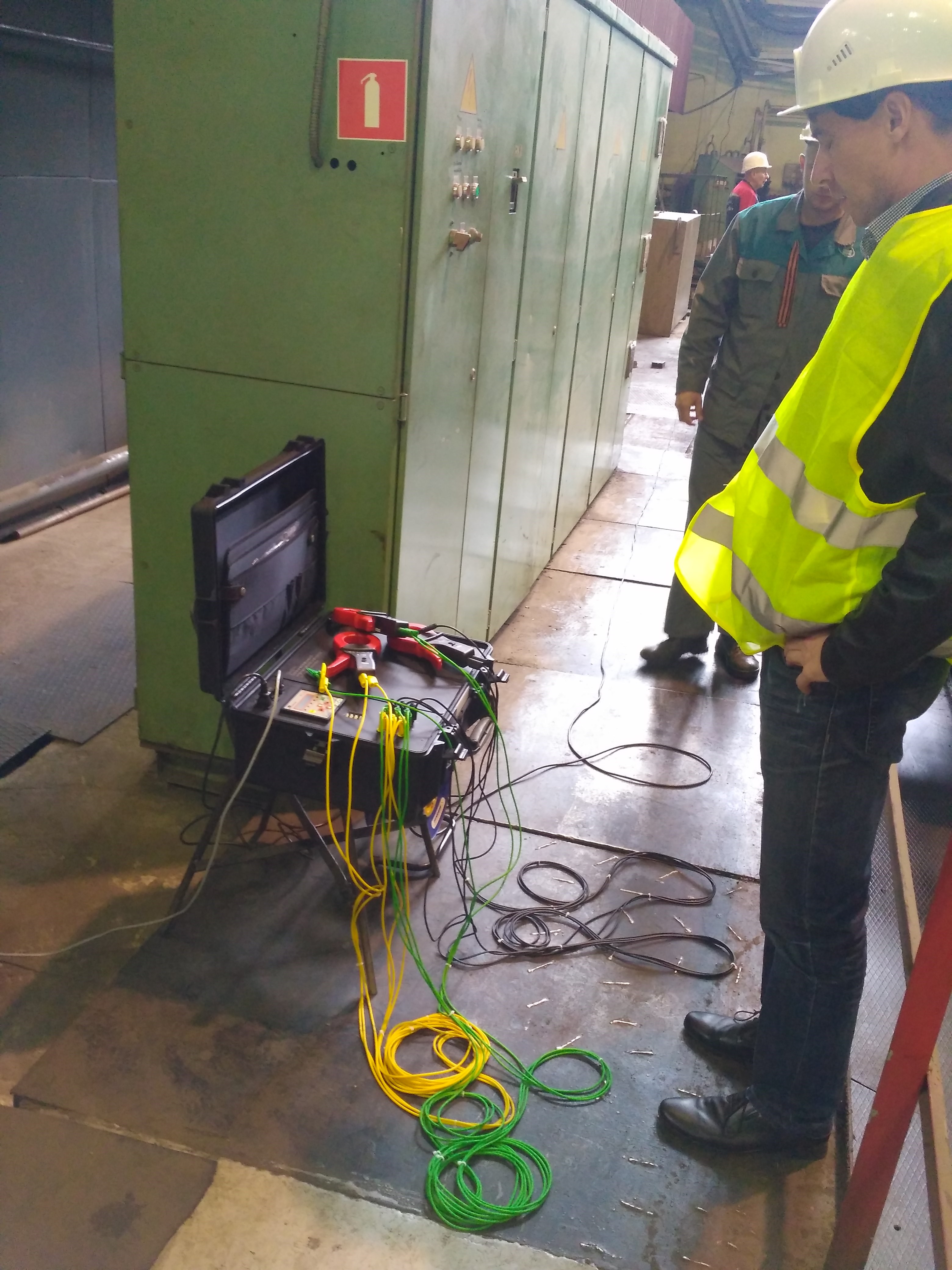
Current spectrum analyzer
Imagine a CHP with turbines, say, 50–60-ies of release. This is about half the capacity of our country. There are huge pumps with electric motors and the same huge generators, which are also electric motors, only “inverted”. They do not have built-in telemetry, and they are diagnosed by successive detours. This was normal at the end of the 70s, but not today.
At thermal power stations, at large drilling stations, at pumping stations and in many other places where the failure of an electric motor or generator is very expensive, there are usually special people who have vast experience in servicing this particular piece of equipment. For example, there may be a grandfather, who by the start sound determines the state of the engine. Or a man-nose, who can sniff the pump so that he feels even the slightest leakage of oil.
')
Modern diagnostics is done a little differently - mainly by vibration sensors. The problem of vibration sensors is that they need to be put on a piece of iron, and a piece of iron on the same drilling rig or submarine is not very accessible. Therefore, we very lively investigated the topic of studying the removal of data from the engine by removing information from the supply circuit. The electromagnetic field transmits much more information, which was previously considered noise. Now it can be analyzed.
How is the diagnosis now?
AC motors with driven equipment (pump, fan) and AC power generators with driven equipment (turbine) are being checked today by thermal imagers (see where bearings heat), sound level meters, various visual inspections (in particular, to assess the color of smudges), and the color of oil measured by spectrographs , gas analyzers and so on. That is, regular rounds.
A possible, but not the only alternative is vibrozamery: the car is hung with sensors from all sides, and then it starts up. By parasitic vibrations one can understand where and what is wrong. This is a normal method of diagnosis and monitoring, which allows not only to understand the status of the machine, but also to prevent an accident. When the vibrations become atypical or too strong, the engine simply stops before it goes racing.
I repeat: there is a difficulty in installing vibrozamers with the installation of sensors - this is not always possible (rather, on the contrary), plus there are a number of diagnostic features (in particular, the methods of vibrodiagnostics are better suited to diagnose mechanical damage to an electric machine and its associated mechanism, may not always be detected in a timely manner). Plus the price, of course, bites for the complex.
Two years ago, software and hardware complexes appeared that allow one to estimate microvibrations of the electromagnetic field. By tracking the various harmonics of the field, one can draw many conclusions about what is wrong with the equipment and where exactly the problem is. The benefit of changing parameters should be cyclical and predictable.
This is a very good idea that has only been implemented relatively recently, when normal data mining algorithms for these indicators and real-time processors appeared, which can be packaged in a relatively compact package. That is semi-portable. Here is this:

How does this devil-machine work
All this is called “the system of automated intellectual diagnostics”. In fact, it makes the engine itself the main sensor, and then removes a lot of data from it with a rather large amount of noise. Then it cleans and restores the data (the most non-trivial part of the calculations), profiles the engine, and with the help of very non-acidic data mining mechanics gives the results to the operator.
The physical principle that underlies this method is as follows: any disturbances in the operation of the electrical and / or mechanical part of the electric motor (electric generator) and the associated device lead to changes in the magnetic flux in the electrical machine’s gap, and therefore to a weak modulation of the consumed (generated ) electric current machine. The presence in the current spectrum of an electric car of characteristic frequencies of a certain size indicates the presence of damage to the electrical and / or mechanical part of the electric motor (generator). Harmonics, multiples of the frequency of the supply current, indicate problems in the electrical part. Harmonics, multiples of the reverse engine speed, are mechanics.

It is necessary to bring the engine to the mode and start shooting data, plus indicate the type of construction for recognition by the neural network (hereinafter I speak about the implementation of the device with which we have been working in Russia for more than a year at the CHP and in the oil sector).
Approximately 15 minutes is spent on profiling the machine. Typical defects are highlighted almost immediately (after an hour or two of work in the mode). For example, in low frequencies - the problem of attaching the machine to the foundation. Characterized by the problems with the rotor, stator, windings. Easily visible circuit in the windings and their other parameters.
More complex defects require the skill of an expert in data analysis - this is not about data mining, but about the knowledge of the design of such electric machines and the experience of their diagnosis.
The device is connected to voltage and current measuring transformers. On low-voltage equipment - directly to the power lines.

We are now working closely with energy - there is a deplorable state of equipment on a number of objects. Much worn out, the service life was extended 2-3 times. Diagnostics is important for them, since generators and turbines are very expensive. The consequences of failure are palpable: accidents, fines on the market, expensive repairs.
For a number of critical objects, continuous monitoring is very important. The system is trained on each piece of equipment and builds thresholds.
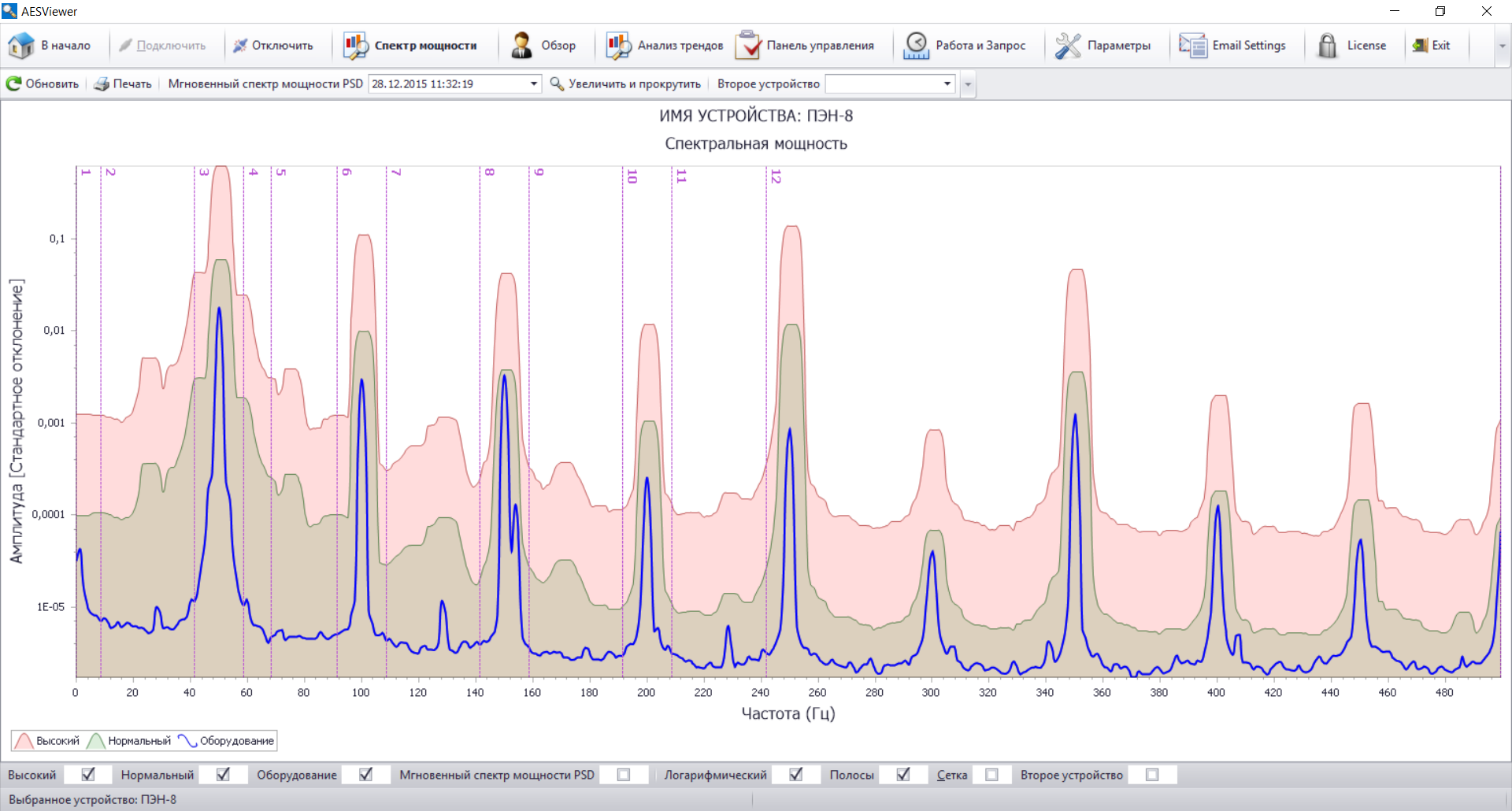
Spectrum of a healthy feed pump of a boiler of a steam turbine power plant
The input signal is the supply voltage, the carrier (mains) frequency of which is modulated by the operation of the motor itself and generates an output signal in the form of the harmonic spectrum of the current consumed.
Profiling is an important point. Two identical large electric motors even in one series only from the factory simply do not exist. Each has its own spectral trace. Moreover, in Russia it is very difficult to find a couple of cars of at least one series on one object. And finally, they were all repaired, modernized and remarked, which left their unique imprints on the nature of the work. The result - there is practically no typical old equipment without a unique design and defects.
Our task in monitoring is to fix the defect, assess its criticality, and then monitor its development. And calculate when it reaches a critical level. And the most important thing is to predict the time of equipment failure.

Such monitoring costs, of course, more expensive than a one-time diagnosis. For the diagnosis you need one set - and go around it with all the machines. And for monitoring - on a set on the engine to constantly watch. They are mounted directly in the shield - and begin to collect and process data.
Analysis Examples
In the example, the type of electric machine is a synchronous motor; driven equipment - piston air compressor; technical characteristics of a synchronous motor: voltage - 6 kV; rated current - 60 A; mains frequency - 50 Hz; nominal shaft speed - 500 rpm; parameters of measuring transformers: voltage transformer - 6000/100; current transformer - 300/5. Types of bearings - rolling bearings.
The blue graph is the "averaged" values of the amplitudes of the current spectrum of the stator. The gray-green area is the profile of the normal operation of the machine, while the machine in it is normal operation, taking into account “long-lasting” defects. The pink area is a warning that does not require an instant stop. The white area is higher than pink - an accident is not far off.
Let us consider in more detail the spectrum graph and analyze it:
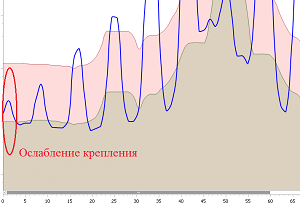
At a frequency of ~ 1 Hz, a peak is observed that goes beyond the average statistical curve of allowable values, which characterizes the weakening of the motor mounting, backlash or excessive tolerances of the clutch of the driven equipment. This defect is not critical yet, but requires verification.
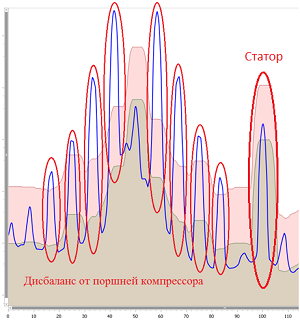
In the region of 50 Hz (power frequency) - peaks, multiples of the reverse frequency of the rotor. These peaks reflect the performance of the compressor pistons. It is possible to track the state during long-term observation.
A peak at 100 Hz is a potential problem with the stator winding. At the moment, it is in the zone of permissible values, but it requires observation (hereinafter - checking the windings).

At a frequency of 150 Hz (3rd harmonic) - a peak exceeding the level of permissible values may cause heating of the stator. May lead to thermal aging and drying of varnish windings (deterioration of winding insulation and short-circuited coils).

At frequencies of ~ 128 Hz and ~ 228 Hz, peaks are observed that go beyond the average statistical curve of allowable values, indicating developing defects in rolling bearings. The specific defect of the bearings can be determined by knowing the type and characteristics of the bearings.
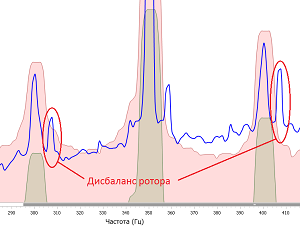
At frequencies of ~ 308 Hz and ~ 408 Hz, peaks are observed that go beyond the average statistical curve of permissible values characterizing the imbalance of the rotor.

At frequencies from 100 Hz to 500 Hz, there is broadband noise. As a rule, such a picture is observed on equipment in which there is a weakening of the attachment of mechanical components (for example, valve play). This defect is significant and requires verification.
More details about the application
Connection is made to measuring transformers in the power cabinet of the diagnosed equipment. Three phases are measured for voltage and current. Low voltage (0.4 kV) - we can directly through the current clamp on the power cables.
The device itself interprets the currents and decomposes into the spectrum. Inside our main implementation is both a small cluster for processing and the device itself for receiving raw data. This is not very logical, but more on that later.
The device periodically saves spectrograms to the internal database. Outside, it is accessible via the web-interface of the AWP of users and the AWS of admin-analysts, as well as AWS of the operating personnel. There is access to the database, if you really need, there is a basic ability to integrate with enterprise systems. But there is no time limit on these types of diagnostics, and we often see that the staff simply do not know what to do when there is an alarm from this equipment. Yes, and the standards appeared only last year - GOST ISO-20958 “Condition monitoring and machine diagnostics. Signature analysis of electrical signals of a three-phase asynchronous motor ”is not even a purely Russian GOST, but between the Russian Federation, the Republic of Belarus and Kazakhstan.
Determined and evaluated:
- defects in the electrical part of the machine: power supply defects, asymmetry of the supply voltage, violation of the contact connection in the supply circuit, problems with reactive power compensator; defects of the machine itself: rotor and stator, short circuit, weakening of the stator windings, etc .;
- defects in the mechanical part of the machine: unbalance of the rotor, defects in the bearings of the rotor machine and the drive equipment, loosening of the attachment to the foundation, defect of the fan blades, oil clogging, machine overload, etc .;
- violation of technological processes: cavitation, turbulence, etc.
The method allows you to identify faults in the electrical and mechanical parts of the machine in the early stages, when their detection by other methods is still impossible. Profiling eliminates the influence of the electromagnetic environment at the installation site of the engine or along the cable route.
Technically, measuring instruments are located at specific pieces of equipment, from which a twisted pair (LAN) passes to a local server (where the data storage is located and processed and provided to users).
In the project - to make a completely Russian development of this device (with its own circuitry, custom components, but with its own assembly) and rewrite sufficiently large pieces of code to change the architecture. We are developing remote diagnostics via SaaS in our data center, because we still see a need for our analysts from time to time to quickly connect and watch or send weekly reports with forecasts for all defects.

The cost of the piece of iron is comparable to normal vibration diagnostic complexes (not Chinese under the Russian brand, but normal European ones). In combination with vibration diagnostics, the systems perfectly complement each other. Based on our system, we can understand the current state of the equipment and determine the module where the defect is. A more accurate place - without disassembly - is sent to find vibrodiagnostic.
Now everywhere there are problems with the loading of staff. He is missing in the field. Taking into account weekends and vacations, each complex needs 2-3 trained people to go and measure at work immediately, if suddenly it is necessary. Another analysis of the spectra of signals is a process, like welding, creative. There are predefined defects, but on our old iron of the same CHP it is necessary to analyze, to have experience. It is necessary to understand the spectra, assemble and disassemble the engines by hand, understand specific instances. There is an urgent need for organizing a process of monitoring and analyzing complex equipment with our specialists. Therefore, SaaS is a logical option in this situation.
Again, through SaaS, our systems can deliver diagnostics and analytics to the operating team. Now many cars are purchased under a service contract (service contracts) from foreign vendors, and there all telemetry goes to the USA or Europe for the support team. Because of the sanctions there is a chance that all this will be covered with a copper basin, so the ability to see the data in real time and store it in itself is very useful.
Approbation
For obvious reasons, due to the price of the system and the novelty of the technology, we encounter many questions. Instead of theorizing, we offer a very simple test for large customers. In any case, they periodically withdraw part of the machines for overhaul. We offer to drive a week before stopping and remove the parameters. And then we send the report with the detected defects, which they will be able to check during detailed disassembly and overhaul.
We offer direct honest testing. And already many customers have traveled. Then they disassemble, look at troubleshooting and compare the results. No matter how much you drive, you almost always hit the bull's eye. But confidentiality and non-disclosure agreements are everywhere, so sorry.
Scopes - thermal power station, machine-tool construction, oil industry (drilling), transport of oil and gas, mechanical engineering, conveyors on electric drives, paper combines, metallurgy (large conveyors and rolling mills), housing and communal services like metro, floating base.
If you have questions not for comments - here is my mail: kgolubev@croc.ru
Source: https://habr.com/ru/post/343000/
All Articles